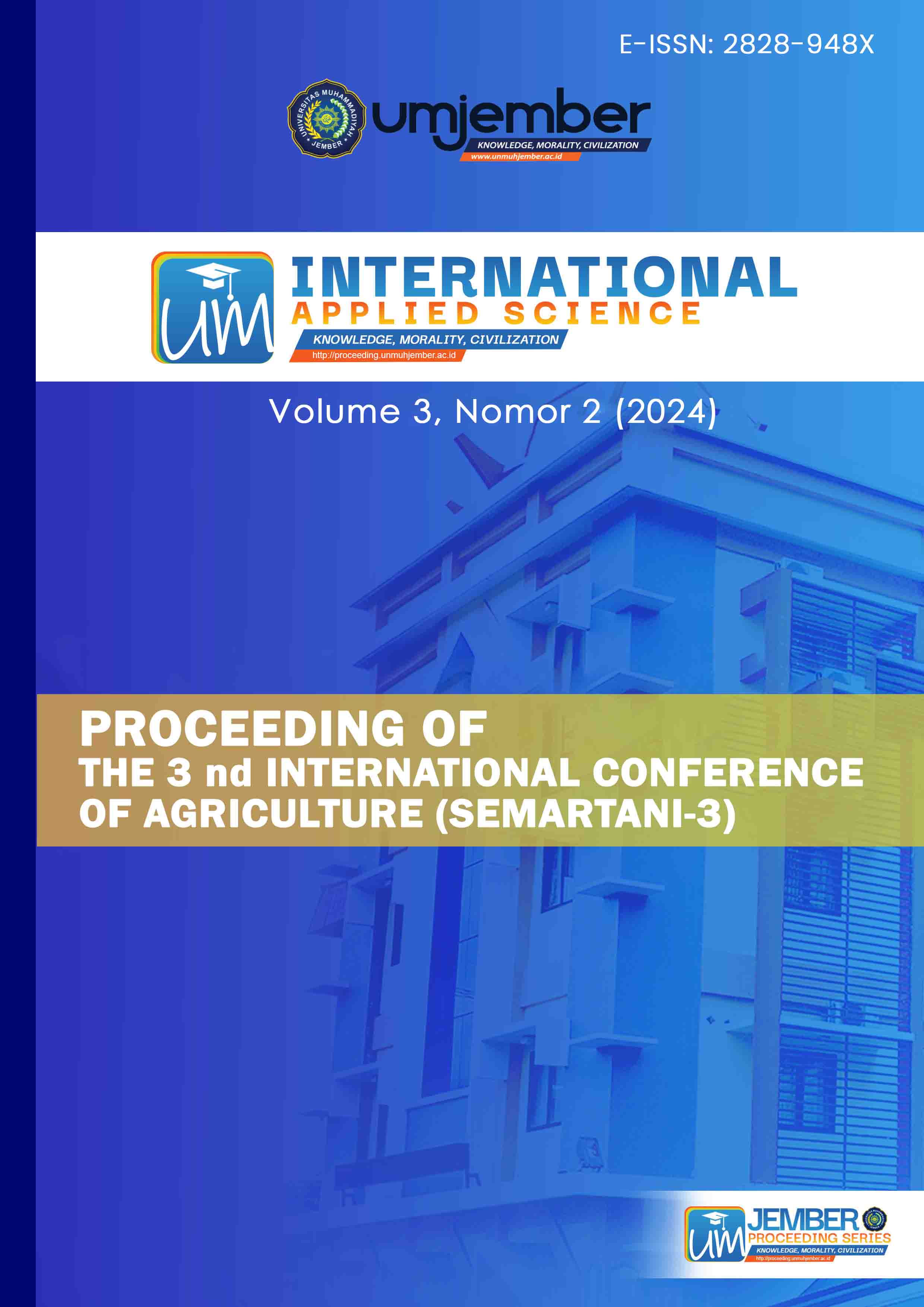Efforts to Propagate Sorghum In Vitro to Support Local Food
DOI:
https://doi.org/10.32528/ias.v3i2.635Keywords:
Sorghum, Callus Induction, 2, 4-DAbstract
indonesia is a country known for its abundant biodiversity. however, the majority of its people still make rice as a daily staple food, making the price of rice continue to increase until it is difficult to reach by low-income people. therefore, it is necessary to develop alternative local food to replace rice to avoid a food crisis. One of the alternative plants is sorghum. Because sorghum has many benefits besides as food as well as bioenergy. That way it is necessary to make efforts to develop sorghum, one of which is by means of embryogenic callus tissue culture techniques by adding a concentration of 2,4-D. This research was conducted in the Laboratory of Nutraseutical and Pharmaseutical Division of Center for Development of Advancd Science and Technologies (CDAST) UPA Waste Management and Integrated Laboratory, University of Muhammadiyah Jember by using Completely Randomized Design (CRD) with a single factor namely A0 (control), A1 1 ppm, A2 2ppm, A3 3ppm, A4 4 ppm which was repeated 3 times. The variables under observation are the callus's color, texture, percentage, and time of formation. According to the study's findings, the application of 4 ppm 2,4-D produced the best results when compared to other 2,4-D treatments. These treatments were able to produce callus at a rate of 4.11 his, 100% of the total number of callus, crumbly texture, and pale yellowish color.
Downloads
References
E. Candrawati, E. Noerhartati, J. N. Sariono, D. Chamidah, and B. Yunarko, “ Perlindungan Hukum Bagi Konsumen Atas Temuan Sorgum Sebagai Bahan Pangan Alternatif Pengganti Beras,,” Pros. Semin. Nas. Cendekiawan, no. April 1999, pp. 1–4, 2019, doi: 10.25105/semnas.v0i0.5898.
Y. M. Dewi Elvira Sari, “Potensi pengembangan sorgum sebagai pangan alternatif,” J. Agroteknologi, vol. 7, no. 2, pp. 27–32, 2017.
A. Anas and A. Suhanto, “ Keragaan Penampilan Lima Genotip Sorgum Manis (Sorghum Bicolor (L.) Moench) Introduksi Jepang Di Jatinangor Indonesia,” Zuriat, vol. 29, no. 2, p. 80, 2018, doi: 10.24198/zuriat.v29i2.20809.
S. M. D. Kolo and E. Edi, “ Hidrolisis Ampas Biji Sorgum dengan Microwave untuk Produksi Gula Pereduksi sebagai Bahan Baku Bioetanol” J. Saintek Lahan Kering, vol. 1, no. 2, pp. 22–23, 2018, doi: 10.32938/slk.v1i2.596.
D. R. Suryaningsih, “Morfogenesis Kalus Sorgum Pada Berbagai Media Secara In Vitro,” J. Appl. Plant Technol., vol. 1, no. 1, pp. 1–8, 2022, doi: 10.30742/japt.v1i1.25.
A. Lutfiah and N. A. Habibah, “Pengaruh Pemberian Elisitor Ekstrak Khamir pada Pertumbuhan Kultur Kalus Gembili dengan Penambahan ZPT 2,4-D dan Kinetin,” Indones. J. Math. Nat. Sci., vol. 45, no. 2, pp. 77–83, 2022, doi: 10.15294/ijmns.v45i2.39728.
G. Jogeswar, D. Ranadheer, V. Anjaiah, and P. B. Kavi Kishor, “High frequency somatic embryogenesis and regeneration in different genotypes of Sorghum bicolor (L.) Moench from immature inflorescence explants,” Vitr. Cell. Dev. Biol. - Plant, vol. 43, no. 2, pp. 159–166, 2007, doi: 10.1007/s11627-007-9033-x.
L. Admojo, A. Indrianto, and H. Hadi, “Perkembangan Penelitian Induksi Kalus Embriogenik Pada Jaringan Vegetatif Tanaman Karet Klonal,” War. Perkaretan, vol. 33, no. 1, p. 19, 2014, doi: 10.22302/ppk.wp.v33i1.46.
Y. P. B. Ziraluo, “Metode Perbanyakan Tanaman Ubi Jalar Ungu (Ipomea batatas Poiret) dengan Teknik Kultur Jaringan atau Stek Planlet,” J. Inov. Penelit., vol. 2, no. 3, pp. 1037–1046, 2021.
R. Maulana, D. P. Restanto, and S. Slameto, “ Pengaruh Konsentrasi 2,4 – Dichlorophenoxyacetic Acid (2,4-D) Terhadap Induksi Kalus Tanaman Sorgum,” J. Bioind., 2019, doi: 10.31326/jbio.v1i2.223.
D. Widiastoety, “Pengaruh Auksin dan Sitokinin Terhadap Pertumbuhan Planlet Mokara,” J. Hortik., vol. 24, no. 3, p. 230, 2016, doi: 10.21082/jhort.v24n3.2014.p230-238.
Amiliza Miarti, “Organoleptic And Dietary Fiber Quality Of Black Pigeon Pea Flour As Bioencapsulation Material,” vol. 2, no. 1, pp. 69–76, 2022, doi: https://doi.org/10.47492/jip.v3i6.1968.
N. Putu Merthaningsih, H. Yuswanti, and D. A. Made Astiningsih, “Induksi kalus pada Kultur Pollen Phalaenopsis dengan menggunakan Asam 2,4-Diklorofenoksiasetat,"Agrotrop, vol. 8, no. 1, pp. 47–55, 2018.
Downloads
Published
How to Cite
Issue
Section
License

This work is licensed under a Creative Commons Attribution-NonCommercial 4.0 International License.


